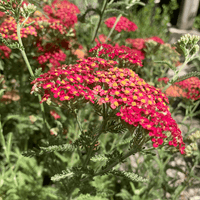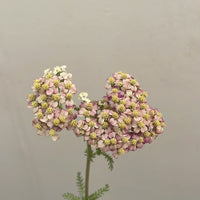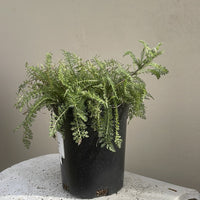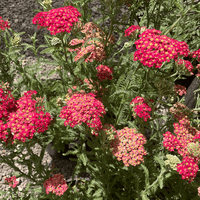



Achillea m. 'Paprika', Yarrow
Paprika Yarrow
A spreading, mat forming herbaceous perennial blooming in June through September and grows up to three feet tall and spreads to five feet wide. An easy to grow rhizomatous plant. Every two to three years divide the clumps to maintain vitality.
Yarrow has deep roots that mine the subsoil for potassium, calcium, copper, phosphorus and magnesium, which makes this plant a nutrient rich mulch.
Known as herbal militaris, for its use in staunching the flow of blood from wounds. Native Americans had many uses for the plant, including pain relief, fever reduction, and blood issues of all kinds. You can also use this to calm and heal rashes, bug bites, bee stings, cuts, and burns.
You can dry the flowers and use them as confetti in batter.
A really great native to attract insects like hoverflies. Hoverflie larvae eat aphids as their primary food source, they are so tiny that the naked eye cannot see them underneath leaves. Adult hoverflies pollinate plants and feed mainly on nectar.
- Plant in full sun
- Plants do well in average garden soils and tolerate poor soils as long as drainage is good
- Moist to dry soil
- Drought tolerant
- Attracts butterflies and bees
-Easy to grow
- Native to Europe, Western Asia, and North America
This content type will accept rich text to help with adding styles and links to additional pages or content. Use this to add supplementary information to help your buyers.
You can use product metafields to assign content to this tab that is unique to an individual product. Use tabs to highlight unique features, sizing information, or other sales information.
Paprika Yarrow
A spreading, mat forming herbaceous perennial blooming in June through September and grows up to three feet tall and spreads to five feet wide. An easy to grow rhizomatous plant. Every two to three years divide the clumps to maintain vitality.
Yarrow has deep roots that mine the subsoil for potassium, calcium, copper, phosphorus and magnesium, which makes this plant a nutrient rich mulch.
Known as herbal militaris, for its use in staunching the flow of blood from wounds. Native Americans had many uses for the plant, including pain relief, fever reduction, and blood issues of all kinds. You can also use this to calm and heal rashes, bug bites, bee stings, cuts, and burns.
You can dry the flowers and use them as confetti in batter.
A really great native to attract insects like hoverflies. Hoverflie larvae eat aphids as their primary food source, they are so tiny that the naked eye cannot see them underneath leaves. Adult hoverflies pollinate plants and feed mainly on nectar.
- Plant in full sun
- Plants do well in average garden soils and tolerate poor soils as long as drainage is good
- Moist to dry soil
- Drought tolerant
- Attracts butterflies and bees
-Easy to grow
- Native to Europe, Western Asia, and North America




